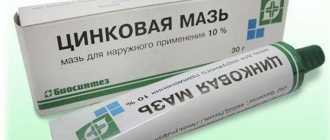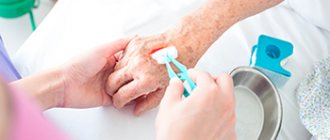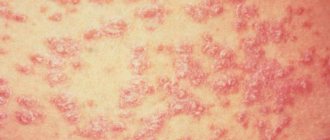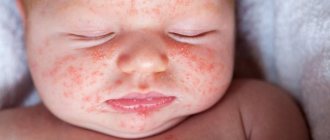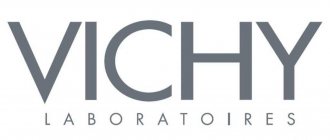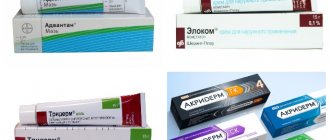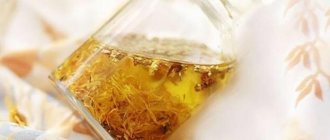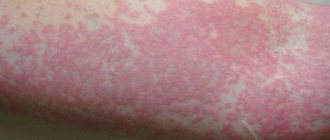If an adult develops an allergic reaction to the epidermis, negative symptoms are sure to appear. For example, rash, irritation, blisters, blisters. If timely therapy is not provided, antigens continue to accumulate, which can lead to a systemic reaction. A dangerous condition is Quincke's edema, which leads to an attack of suffocation and death. Urticaria has negative symptoms. To eliminate the condition, it is necessary to use medicinal ointments containing antihistamines and steroids. They have positive and negative sides.
Types of antihistamine ointments
To eliminate allergic reactions, mandatory medication is required. They can be applied topically, which reduces the risk of side effects. There are hormonal and non-hormonal types of ointments. Each of them has its own advantages and disadvantages and are prescribed depending on the degree of development of clinical symptoms.
- Non-hormonal creams
. Used for mild hypersensitivity manifested on the skin. After application, the action develops immediately. The maximum effect is observed within 2 hours. Itching, redness and other reactions are reduced. - Corticosteroid drugs
. They are applicable for patients with severe cases of allergies. They are especially often prescribed to patients with a predisposition to urticaria and angioedema. The drugs have a large number of contraindications and side effects, so they must be used with caution, no more than 10 days. Otherwise, there will be an aggressive effect not only on the epidermis, but also on the entire body.
Some patients may be prescribed corticosteroid ointments for a course of treatment of up to 1 month. But for this there must be strict indications for use. We recommend products that contain a minimum concentration of steroids and a reduced number of adverse reactions. Usually this is the latest generation medicine.
If the patient's condition is complicated by the addition of bacterial microflora, suppuration develops. The condition cannot be treated with gentle methods; antibacterial drugs are required. Then the inflammatory process, allergic reaction, and pathogenic microflora are eliminated. This will prevent the spread of bacteria into the systemic circulation.
If you use hormonal drugs for an excessively long course, skin atrophy will occur. Necrotic areas will form on it. A similar symptom develops when the dosage is exceeded or self-treatment.
Symptoms[4]
Allergic dermatitis is characterized by the appearance of large red spots on the skin with small blisters. The bubbles are filled with liquid. When the blisters burst, serous exudate begins to ooze. This is the so-called oozing, which then forms a crust of dying tissue and fluid.
With contact dermatitis, there is increased sensitivity of the skin; redness and blisters appear in areas of interaction with the allergen. With toxicoderma, a diffuse spread of papules is observed, areas of the skin become swollen, intense itching and general reactions appear (increase in body temperature, increase in leukocytes in the blood).
In some cases, allergic dermatitis develops after contact with chemicals and first manifests itself as a normal contact dermatitis, and then acquires a toxic-allergic form. The rash is accompanied by severe itching, and sometimes the temperature rises. A similar course is typical for toxicoderma, when after contact with drugs, rashes first appear on the neck, arms, face and allergic rhinitis develops, and then signs of toxic-allergic and autoimmune reactions appear.[5]
Positive aspects of ointments
Positive effects of ointments to eliminate inflammation and allergic reactions:
- rapid effect on the lesion;
- immediate anti-inflammatory effect, eliminating redness, swelling, pain;
- relieving any kind of discomfort, which has a beneficial effect at night;
- moisturizing effect, eliminating cracked, dry areas of the skin;
- reducing the risk of complications such as bacterial infection;
- activation of regenerative processes;
- reducing the risk of relapse;
- availability of drugs, ease of use.
Most ointments with antihistamine and anti-inflammatory effects can be used in combination therapy with other drugs. But first consult with a doctor to prevent cross-interaction of active ingredients.
Local hormonal drugs
Doctors often prescribe medications containing hormones to suppress the inflammatory response and eliminate allergies.
Advantan
This is a drug of the latest generation, causing a gentle effect. It can be used for up to 3 months. Recommendations for use:
- application in a thin layer, careful distribution over the affected area;
- if an allergic reaction develops in the eyelid area, the period of therapy is reduced to 1 week.
The effect develops in the first hour, the patient feels relief and itching is eliminated.
Sinaf
This is a first-generation drug that has a fast and high-quality effect, but has many side effects. For example, atrophy of the skin may gradually develop. Therefore, the drug is used for a maximum of 10 days, applied once a day if discomfort occurs. If a qualitative effect occurs, the treatment period is reduced to 1 week.
Comfoderm
A drug of the latest generation that has a gentle effect on the affected epidermis of adults. It is applied in a thin layer to the affected area, avoiding healthy skin. This helps reduce the risk of adverse reactions. Recommendations for use:
- application to clean skin;
- use once a day for an allergic reaction;
- The maximum period of use is 1 month, but it can be applied to the face for no more than 5 days.
If the patient develops a chronic inflammatory process of the epidermis, the period of therapy can be extended to 3 months. But it is necessary to monitor the development of negative reactions.
Elidel
The drug is applied to various parts of the body, regardless of the development of the allergic process:
- face, head, neck;
- body, limbs.
The drug can be used for a long time; it is discontinued when inflammation is suppressed. It is recommended to apply 2 times a day, in a thin layer. Be sure to wait until the product is completely absorbed.
To prevent side effects, the use of the hormonal drug is discontinued gradually. Otherwise, withdrawal syndrome will develop, worsening the quality of the epidermis.
Contraindications
Sinaflan should not be used for the following skin pathologies:
- for mechanical damage to the integument: wounds, abrasions, ulcerative processes;
- when tissues are damaged by viruses, fungi, bacteria, herpes and other infectious agents;
- for skin tuberculosis;
- benign and malignant neoplasms: including on the surface of birthmarks and moles.
Hormonal ointment should not be used for application to the mucous membranes of the eyes, mouth, or nipple halos. It is undesirable to treat formed psoriatic plaques with clearly disturbed epithelial structure. This drug should also not be used for acne and inflammatory nodules of unknown origin, demodicosis. The glucocorticoid in its composition can provoke further skin damage, aggravating the clinical picture.
You will also have to exclude parking during pregnancy and lactation, since the hormone can cause unwanted reactions in the child’s body.
Local non-hormonal drugs
These are more gentle means that can be used over a long course without fear of developing negative reactions. But they should be applied with caution, since exceeding the dosage and taking without prescription is not recommended.
Skin cap
The ointment has a high price, but a high-quality effect. This is the latest generation drug, used according to the following recommendations:
- shaking the bottle before use so that the concentration of the active substance is distributed throughout the ointment;
- application only to areas of affected skin, without affecting healthy tissue;
- application 2 times a day, morning and evening;
- preliminary cleansing of the skin is not required;
- The duration of the course of application is 1 month.
The only contraindication is individual intolerance. As it develops, the negative symptoms of hypersensitivity intensify.
Zinc ointment
One of the cheap but high-quality products that has the following effects:
- anti-inflammatory;
- disinfectant;
- drying.
Before applying the product, pre-clean the affected epidermis. Then apply up to 3 times a day. The drug is approved for young children and pregnant women due to its beneficial effect on the body and reduced risk of side effects. It can be used as part of complex therapy with other drugs.
Bepanten
This is a remedy used to enhance the regenerative effect of cells. It is additionally used for allergies to reduce inflammation and moisturize the skin. Recommendations for use:
- application 2 times a day, morning and evening;
- the course of use is unlimited, so the drug is applied continuously until the negative symptoms are eliminated.
The drug cannot be used for all types of allergies. It is not recommended for use on wet wounds. It moisturizes the skin, therefore enhancing the formation of exudate.
Belosalik
Helps with various types of allergic skin reactions in adult patients. Used for a maximum course of up to 4 weeks. To prevent secondary infection, pre-treat the epidermis with an antiseptic. Then the active component will penetrate as deeply as possible, causing an anti-inflammatory effect. The drug is used 2 times a day. It effectively eliminates skin rashes.
Non-hormonal ointments can be used at different stages of therapy. Additionally applicable when the allergic reaction has almost disappeared, but tissue restoration needs to be enhanced.
Local ointments with additional antibacterial effect
Such products are recommended to be used if there is a risk of developing a bacterial infection or if it has already formed and therefore purulent areas have arisen.
Levomekol
This is an effective drug that simultaneously eliminates inflammation, swelling, and bacterial infection. The maximum effect is achieved when using a compress. Recommendations for use:
- application 1 time per day;
- preliminary distribution on a bandage or gauze, which is then applied to the lesion, the bandage is kept for a day.
The ointment is so safe that even pregnant women can use it. The optimal course is 7 days, since the composition includes an antibacterial component.
Erythromycin ointment
The ointment can be used for the eyelids and areas of the face without fear of damage to the epidermis. The following effects occur:
- anti-inflammatory;
- antibacterial;
- moisturizing.
It is prescribed for allergies if a complication occurs in the form of a bacterial infection with purulent formations. The drug is applied 3 times a day, spreading it over the epidermis in a thin layer. The maximum duration of treatment is up to 2 weeks.
Fucidin
This is an ointment containing an antibiotic, so the maximum course of use lasts no more than 10 days. Recommendations for application:
- the skin is first cleaned with an antiseptic;
- apply a thin layer 3 times a day;
- The same amount of time is maintained between each use of the ointment.
The composition of the cream is safe, so it can be applied to areas of the face.
Video
Useful video with an opinion on the use of Sudocrem cream
Hormone-free creams are available in pharmacies without prescriptions. Their abundance is associated with a narrow spectrum of action: Bepanten eliminates inflammation, La-Cri saves the epidermis from exposure to low temperatures, Sudocrem is one of the few that can be applied to the delicate skin of infants.
In most cases, external manifestations indicate internal contact with the pathogen. Even if you probably know the cause of a negative reaction, only a specialist can select the right drug.
Ointments to eliminate irritation
If the allergic reaction does not develop strongly and forms at the site of irritation, gentle ointments are recommended.
Flucinar
This is a cream designed to eliminate itching, burning, and irritation. The mechanism of action is fast, so the listed symptoms are eliminated instantly. Method of use:
- application 2 times a day with equal intervals;
- distribution of a thin layer of cream, which is carefully applied with massage movements;
- The maximum period of therapy is 1 week.
If symptoms have not completely resolved within 1 week, it is allowed to extend therapy up to 14 days.
Prednisolone
A hormonal drug that causes a rapid effect, but has an aggressive effect on the affected area. Therefore, it is recommended to use it for no more than 7 days. If the patient develops urticaria or other severe reactions, treatment can be extended to 10 days. The ointment is applied in a thin layer without pre-treatment of the affected area. It can be applied no more than 3 times per day.
Akriderm
The drug has a combined effect:
- elimination of itching, burning, pain;
- relieving the inflammatory process.
When using the product, follow the recommendations:
- the maximum duration of treatment is 7 days;
- 2-3 thin layers of ointment are allowed in 1 day.
The drug should not be used during pregnancy, breastfeeding, or in patients with renal failure, since a small amount of the hormonal component penetrates into the systemic bloodstream.
Self-administration of hormonal drugs can aggravate the patient's condition. They are recommended to be used only in strictly controlled dosages, as prescribed by a doctor.
Prices for allergy medications
The table shows the approximate cost of different drugs to suppress hypersensitivity.
| Medicine | Price in Russia, rub. | Price in Belarus, rub. | Price in Ukraine, hryvnia |
| Skin cap | 850-2800 | 27-93 | 250-1300 |
| Zinc ointment | 28 | 1 | 11 |
| Levomekol | 145 | 5 | 59 |
| Advantan | 580-1280 | 18-40 | 239-520 |
| Sinaf | 95 | 2,3 | 39 |
| Comfoderm | 490 | 15 | 199 |
| Bepanten | 480 | 15 | 190 |
| Erythromycin ointment | 140 | 4 | 58 |
| Fucidin | 590 | 18 | 238 |
| Belosalik | 680 | 21 | 290 |
| Flucinar | 280 | 8,7 | 119 |
| Prednisolone | 48 | 1,4 | 19 |
| Elidel | 890 | 33 | 356 |
| Akriderm | 89 | 2,9 | 37 |
Prices are approximate, each pharmacy may have its own markup, so the cost differs.
If the patient has a rash, itching, blisters, redness and other negative symptoms on the skin, do not select the drug on your own. They can form both during an allergic reaction and during an infectious process, the spread of mites, and other conditions. Therefore, consultation with a dermatologist, venereologist, allergist, and other specialists is required. If the cause is identified early and treatment is started, only a topical ointment may be required without oral or injected medications.

